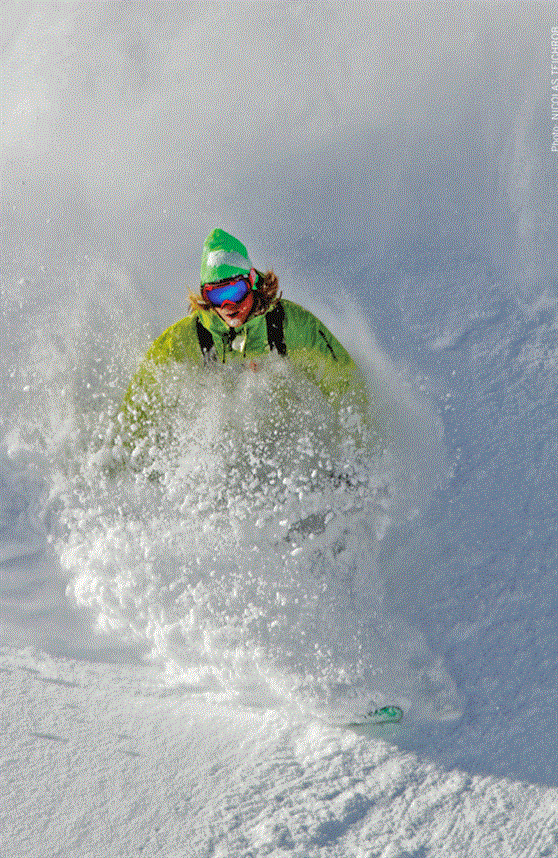by George Koch in Western View from Winter 2012 issue

As an international ski writer who spends virtually all winter on the slopes (it’s charming how many people I meet think that’s not a lie), I’m frequently asked whether I prefer heli-skiing or snowcat skiing. Canadian, European and American skiers are equally curious, although coming at it from different angles.
Europeans, for instance, revere heli-skiing and think they know all about it. But they can’t quite visualize a “piste maschine” used to haul people uphill. Isn’t it ice-cold? Don’t you fall off? And they become grimly humourless when the subject is skiing “in the forest,” which they liken to environmental despoliation (envisioning soft skiers’ bodies somehow hacking apart metre-thick firs). Canadians, by contrast, adore the snowcat for its reliability and lower price. When it comes to heli-skiing, however, their risk-aaversion, ingrained frugality and anti-elitism seem to keep them away. For Americans, it’s not about machismo, they just want to maximize their powder turns and are happy to spend money, as long as there is any.
So which mode is actually better? (I’m talking about multi-day powder holidays here, not resort-based day-operations, a vastly different ski product.) There’ve been times while heli-skiing when I’ve felt like Icarus himself, roaming vast distances to alight on the perfect exposure miles from the last run, tumbling out of the helicopter to gaze at peaks off on the horizon and realizing, that’s where we stood yesterday. Unlike dining in a rocking cat, lunch heli-skiing is taken in some snowbank where the vista rivals all others for the day’s best. There’s no feeling like it. And that’s before you make the first turn of a run that might drop 1500 vertical metres. Some snow-cat skiing lodges boast of having “a” glacier. While heli-skiing you might fly over 15 and ski five or more in a day, the underlying ice maintaining perfect snow from drop-off to pickup. Times like that I feel as if I’m the luckiest guy alive.
Then again, heli-downtime is almost unbearable, while those on-again, off-again days when he fog rolls round and the skiing consists of a few lame front-range runs are nearly as bad. Times like that I ache for a snowcat and the seemingly limitless number of tree runs at a place like Monashee Powder. The snowcat is weatherproof. Most of my best snowcat-skiing days have been in anything from dubious weather to outright blizzards. In beautiful B.C. the snowfall can reach over five cm per hour, bringing powder that on the last couple of runs is a foot deeper than on the day’s opener. That’s just as delicious as the best moments in heli-skiing.
Many people try to parse the numbers and conclude snowcat skiing is better value. I think it’s a fool’s errand. True, snowcat skiing goes for about $4,000-$7,000 per week versus $7,000-$12,000 for heli-skiing—and far more if you sign up for a small “private ” group. But what’s a vertical metre worth? What’s your time worth? Historically, a well-run heli operation could offer its guests two to two-and-a-half times the daily vertical of snowcat skiing. See how the math equals? And if you’re a well-paid professional with limited time off, heli-skiing could well be the more cost-effective choice.
But the lines are blurring. While one still hears barroom talk of 60,000-vertical-foot heli-days, aging skiers and rising costs have seen most heli ops bring the daily vertical out of the stratosphere—sometimes almost to comparative levels. Meanwhile, snowcat operations like Mustang Powder have fine-tuned road designs, group management and snowcat models to routinely achieve 20,000-vertical-foot days— sometimes even 25,000. I’ve had heli-days well below that.
Most skiers think of the snowcat setting as more collegial and less elitist. As long as you’re not one of the few who suffers from motion sickness, the long uphill rides make for more fulsome conversation and stronger bonding. Heli-skiing still attracts its share of snobs. But the difference is less than you might think. Smaller heli outfits offer a lodge atmosphere indistinguishable from that of a snowcat setting. Even big heli operations like posh Mike Wiegele’s in Blue River work hard to foster social ties. Sitting together at dinner every evening and having the same guide each day help create a small-group atmosphere
among the much larger sea of guests.
Usually the most contentious topic in my heli vs. snowcat conversations is musing about the terrain one might actually ski. Although I still hear rumours of ultra-steep terrain being skied by private small groups of trusted repeat guests at certain heli ops, my experience has encountered a clear pattern: snowcat skiing is consistently steeper. That’s likely because most of it takes place in the trees and the area being worked is small enough that skier-compaction helps stabilize the snowpack. It’s been over a decade since I skied a seriously steep run out of a helicopter. At some snowcat operations steep runs are so plentiful it’s hard to keep their names straight. Mustang Powder recently dialled it up further with its Small Groups–Steep Chutes program, which offers some of the steepest skiing you’ll find anywhere plus the chance at a first descent of never-before-skied terrain (as I wrote about in SC’s Buyer’s Guide 2012 issue).
A few heli ops have taken notice. Purcell Helicopter Skiing at Golden recently introduced steep skiing clinics—later in the season and when snow stability allows. A few operators are even attempting to fuse the two genres. Mike Wiegele has had a snowcat component for a number of years on enormous Saddle Mountain within view of his Heli Village. So does Great Northern Heli-Skiing at Terrace, B.C. Meanwhile, Chatter Creek Snowcat Skiing is offering by-the-run and full-day heli-skiing, sometimes in conjunction with a snowcat pickup or drop-off. Definitely sounds worth checking out.